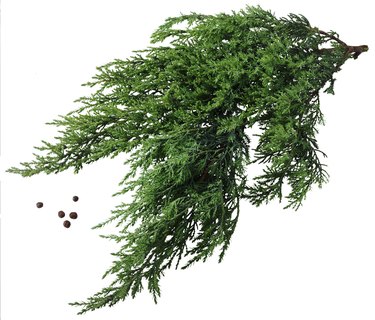
Juniperus horizontalis, creeping juniper, is a shrub that occurs in the northern United States and Canada. It is low growing and evergreen and is often used for groundcover. Though it is known as being quite hardy, the creeping juniper can begin to brown for a variety of reasons, including improper watering, poor soil conditions and pests. Blight can be a serious problem for creeping juniper and cannot only brown but can eventually kill the shrub.
Blight
Video of the Day
Various types of blight can affect creeping juniper, which is why the disease can be such a problem for the shrub. Symptoms of blight include yelling spots on the foliage. As the disease progresses, the foliage will begin to turn brown. Cankers will then form, usually killing the browning part of the shrub. To treat blights, prune away any damaged or browning foliage and treat the rest of the shrub with a fungicide according to the application instructions.
Video of the Day
Pests
Though more rare, several pests can infect creeping juniper, which can cause the foliage to brown. These include mites and some worms. Pests of this nature can sometimes be treated by simply regularly watering the shrub, which flushes the pests off of the foliage. If flushing doesn't work, a chemical control method, such as an insecticide or miticide, should be applied to the shrub. Only use chemical controls as the last resort because in addition to killing the pests, they will also kill the pests' predators, which could leave the shrub susceptible to pests in the future.
Water and Light
Creeping junipers prefer full, bright sunlight throughout the year. If you live in an area where the sun is very strong in the summertime, make sure that you supplement the conditions by watering more frequently. Watering in the early morning can help keep the soil moist and also prevent the foliage from burning and browning. Move your creeping juniper into an area of full sunshine if you have it currently planted in partial to full shade, which could be another reason for it to brown or rot.
Soil Condition
Soil amendments, such as loam or sand, can help increase the soil's ability to drain, which is important for the creeping juniper to thrive. If the soil does not drain well, it could be a reason for it to turn brown, which could stem from unhealthy or rotted roots. If your soil does not drain well, incorporate sand or loam into the first few inches of the soil with a hand tiller.